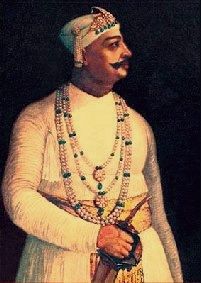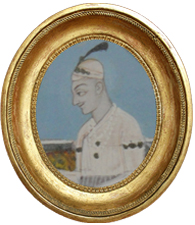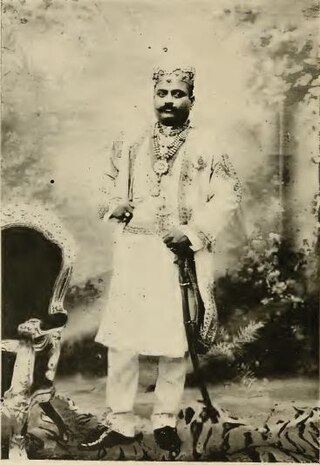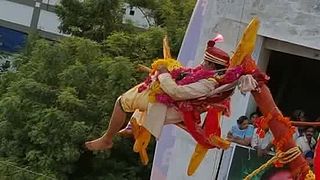
Paigah family was a noble family from the former Hyderabad State. The family maintained their own court, individual palaces, and a standing army of about fourteen thousand infantry and cavalry troops.

Bobbili is a town in Vizianagaram district of the Indian state of Andhra Pradesh.

Sikander Jah, Asaf Jah III, was the 3rd Nizam of Hyderabad, India from 1803 to 1829. He was born in Chowmahalla Palace in the Khilwath, the second son of Asaf Jah II and Tahniat un-nisa Begum.

Salabat Jung, born as Mir Sa'id Muhammad Khan Siddiqi Bayafandi on 24 November 1718, was the fourth Nizam of Hyderabad State. He was the third son of Asaf Jah I.
Raja Sri Ravu SvetachalapatiSir Ramakrishna Ranga RaoKCIE was an Indian politician and zamindar who served as the First Minister of Madras Presidency from 5 November 1932 to 4 April 1936 and 24 August 1936 to 1 April 1937.

Charles Joseph Patissier, Marquis de Bussy-Castelnau or Charles Joseph Patissier de Bussy was the Governor General of the French colony of Pondicherry from 1783 to 1785. He served with distinction under Joseph François Dupleix in the East Indies, receiving the Order of Saint Louis. He contributed to the recovery from Britain of Pondicherry in 1748, and was named in 1782 to lead all French military forces beyond the Cape of Good Hope. He coordinated his operations with Pierre André de Suffren and fought against the British during the Indian campaigns of the American War of Independence.
The Battle of Bobbili, comprising the attack on the fort of Bobbili on 24 January 1757, was a significant event in the princely state of Vizianagaram. Gen. Tandra Paparayudu gained the sobriquet The Tiger of Bobbili for his fierce, ultimately hopeless resistance, and final vengeance.

Banjara Hills is an urban commercial centre and one of the most affluent neighbourhoods in Hyderabad, Telangana, India. This is an upmarket locality close to Jubilee Hills. This area was a hilly forest and was least inhabited in the past. Only a few royal members of the Nizam's dynasty lived here, which was a hunting ground for them. This area now has completely been transformed to an urban commercial centre consisting of an array of high-end hotels, restaurants, night clubs and office buildings of global corporations. Banjara Hills is segregated by its road numbers, with each road having its own importance: the numbers run from 1 through 14.

Sir Sri Venkata Svetachalapathi Venkatesh Srinivasa Ranga Rao Bahadur was an Indian landlord, maharaja, polygar,and zamindar of Bobbili in Madras Presidency; List of zamindari estates in Madras Presidency;from 1881 to 1921. His grandson and successor Raja Sir Sri RAMAKRISHNA SVETA CHALAPATI Ranga Rao Bahadur, K.C.I.E. served as the Chief Minister of Madras Presidency from 1932 to 1936.

Sirimanothsavam, is a festival organized to propitiate Goddess Pyddithallamma of Vizianagram Town. Siri means "goddess Lakshmi in other words wealth and prosperity " and manu means "trunk" or "log". The priest of the temple, while taking procession between the fort and temple three times in the evening, hangs from the tip of the long, lean wooden staff, raised high into the sky. The priest possessed by the goddess would himself tell a few days before, where this manu would be available. It is from that place only the log has to be procured. Hanging from the upper end of the staff, which is raised high into the sky, is a very risky exercise, but it is believed that the grace of the Goddess protects the priest from falling off. It is held in the month of September or October (Dasara) of every year. It is a great carnival attended by two to three lakhs of people from the neighboring towns and villages. The Rajas of Vizianagaram oversee the arrangements for this event. The APSRTC runs about 250 buses from different parts of the state to facilitate transport of devotees to Vizianagram to attend this festival.

Bobbili Yuddham is a 1964 Indian Telugu-language war film, based on the Battle of Bobbili between Bobbili and Vizianagaram kingdoms in 1757. The film was produced and directed by C. Seetaram. It stars N. T. Rama Rao, Bhanumathi Ramakrishna, S. V. Ranga Rao with music composed by S. Rajeswara Rao.

The Siege of Trichinopoly was part of an extended series of conflicts between the Nizam of Hyderabad and the Maratha Empire for control of the Carnatic region. On 29 August 1743, after a six-month siege, Murari Rao surrendered, giving Nizam ul Mulk (Nizam) the suzerainty of Trichinopoly. By the end of 1743, the Nizam had regained full control of Deccan. This stopped the Maratha interference in the region and ended their hegemony over the Carnatic. The Nizam resolved the internal conflicts among the regional hereditary nobles (Nawabs) for the seat of governor (Subedar) of Arcot State, and monitored the activities of the British East India company and French East India Company by limiting their access to ports and trading.
Maharajah's Government College of Music and Dance is an educational institution in Vizianagaram, Andhra Pradesh, India. It is the first music college in South India.

Gadwal Samsthanam was a vassal of the Nizam of Hyderabad. Once part of Raichur district, it is now Gadwal in Jogulamba Gadwal district. It was one of the three important samsthanams, the other two being Wanaparthy Samsthanam and Jatprole Samsthanam.

Tandra Paparayudu was an Army General of Bobbili who assassinated Pusapati Vijayarama Gajapati Raju I Raja of Vizianagaram, and committed his Royal suicide during the Battle of Bobbili in 1757, a significant historical event in the Princely state of Vizianagaram, the present day Vizianagaram district of Andhra Pradesh.
The 1903 New Year Honours, announced at the time as the Durbar Honours, were appointments to various orders and honours of the United Kingdom and British India. The list was announced on the day of the 1903 Delhi Durbar held to celebrate the succession of King Edward VII and Queen Alexandra as Emperor and Empress of India. The membership of the two Indian Orders were expanded to allow for all the new appointments.
The 1911 Delhi Durbar was held in December 1911 following the coronation in London in June of that year of King George V and Queen Mary. The King and Queen travelled to Delhi for the Durbar. For the occasion, the statutory limits of the membership of the Order of the Star of India and the Order of the Indian Empire were increased and many appointments were made to these and other orders. These honours were published in a supplement to the London Gazette dated 8 December 1911.

Bobbili Estate was a Zamindari in the Vizagapatam District of the Madras Presidency, presently in the Vizianagaram district, Andhra Pradesh, India. It comprises 153 Jeroyati villages, 53 Agraharams, 5 Mokhasas by 1907 and a revenue of 8,33,000/- by 1938. It is one of the most influential Zamindari. It is spread over 300 square miles. It also bought shares in many estates like Kirlampudi, Dontamuru etc. It prospered in the period of British Raj.
Ravu Venkata Sujay Krishna Ranga Rao is the former Minister of Mines in the cabinet of N. Chandrababu Naidu from 2014 to 2019, Andhra Pradesh, India.

Amir-e-Paigah-e-Asman Jahi, Moin-ud-Daula Bahadur Innayath Jung, commonly known as Sir Nawab Muhammed Moin Uddin Khan born at Basheer Bagh Palace in 1891 was an Indian nobleman and member of the Paigah Nobility and the Amir of the Asman Jahi Paigah one of the 3 great Paigahs of Hyderabad State The Paigah Nobility was the second most powerful family in Deccan Hyderabad State maintaining their own court and army bound with Asaf Jahi dynasty by matrimonial relationship, Moin-ud-doula and his father Asman Jah was one of those fortunate individuals to whom it has been given by fate to write their names large in the annals of their country, Moin-ud-doula's father Asman Jah who served as co-regent and Prime Minister of Hyderabad created several marvelous architects throughout the city maintained his army court in his domain Shamshabad, was granted the title of Order of the Indian Empire,















